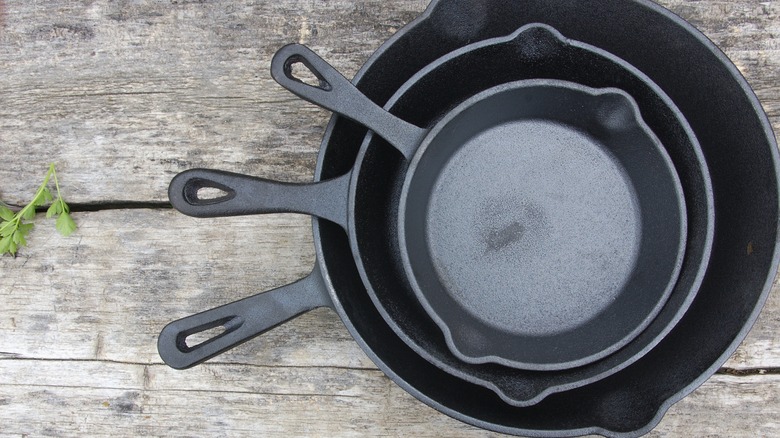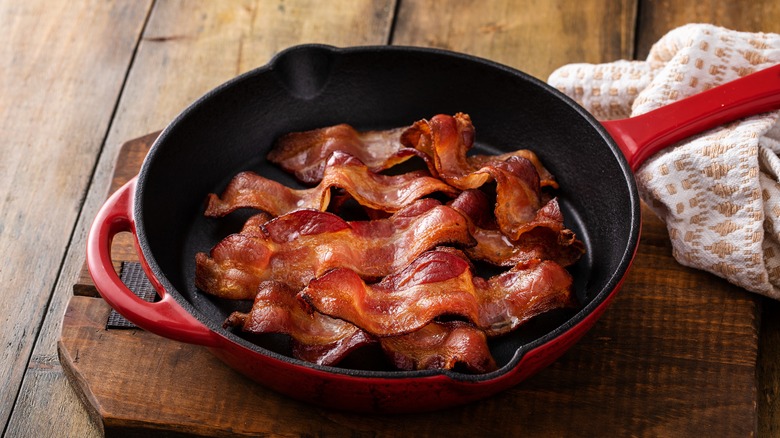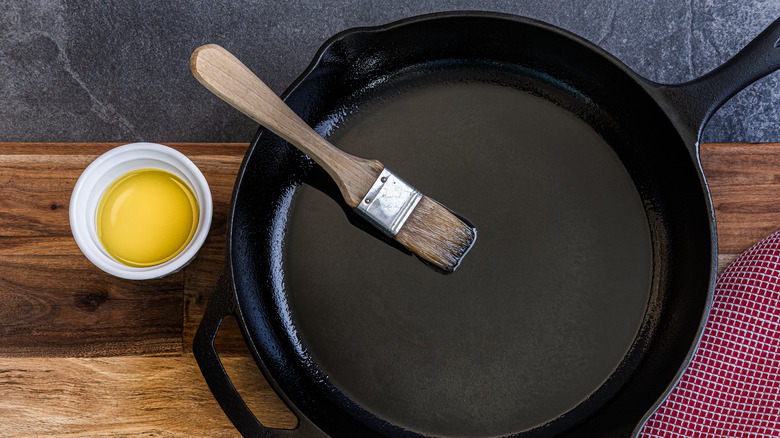Why Your Cast Iron Skillet Has A Rough Surface
Cast iron skillets have long been the gold standard for cooking hearty meals. The sturdy surface that retains high heat provides a perfect sear for meat and fish, and these oven-safe pans are also great for making anything from hash browns to stews to the crunchiest bread loaves. Not to mention that cast iron skillets can literally last a lifetime — well-maintained pans can be passed down through generations.
Despite its popularity, there's something of a mystical quality to the cookware, with home cooks asking about how they're made and how to best take care of them. One thing you might wonder is why cast iron skillets have such a rough texture. After all, most other styles of cookware prioritize a smooth, almost slippery surface. Owners of vintage cast iron skillets will note that theirs are smooth as marble, so why do pans on the market today have that bumpiness?
The texture of modern cast iron pans can be traced back to the mid-20th century, when manufacturing companies decided to speed up production by skipping out on a certain step in the pan-making process. Prior to this, much smoother cast iron pieces were the norm, but this new move put rougher pans back on the market.
How cast iron skillets are made today
Cast iron skillets are made by pouring molten iron (often mixed with other materials, depending on the brand) into molds made of sand. After setting, the molds are broken to release the skillets, and the surfaces are sanded down to make them smoother. Then, the pans are typically pre-seasoned, so that they are ready to cook with when you take them home. Alternatively, they might be enameled, such as with Le Creuset pans and Dutch ovens.
This process is similar to how cast iron was made as far back in the early 19th century, but much quicker. Vintage cast iron skillets were tumbled for a long time, in order to remove sand from the mold and make the surface of the skillets super smooth. These days, that step is skipped so that some of the sand remains, making the surface rough. You won't be getting sand in your food, to be clear — the leftovers manifest as bumps and pits on the metal, not actual grains.
Most modern cast iron skillets are sold pre-seasoned to help offset the bumpy texture. Seasoning is the process of baking layers of oil onto the surface of cast iron to make it non-stick, usually by rubbing a light layer of neutral oil with a high smoke point over the pan after each use. The next time you use it, that oil will heat up and polymerize, strengthening the non-stick layer.
How to make a cast iron skillet more smooth
Pre-seasoning means that a company has started the seasoning process for you, so your pan is ready to use. If you really don't like its rough texture, though, there's no need to worry. Over time, if you season your pan continuously, the polymerized oil will chemically fuse with the pan and create something like a second skin, which will eventually help to smooth out the surface. Dedicated seasoning sessions of oiling the pan and then baking in a very hot oven, then repeating if necessary, can further fill in the bumps and dents.
Bumps on the surface of the pan create opportunities for food to stick, so it's important that every time you use your cast iron, you wash it, dry it, and polish it with a light layer of oil. Some will tell you to avoid soap, but a small amount can be necessary to clean food residue, and most dish soap today doesn't contain lye, which is what can really damage cast iron. If you don't properly wash your skillet, food residue can turn black and flake off, creating the illusion that your seasoning is deteriorating.
For stubborn residue, you can also clean your cast iron the long way, which involves a simple but effective soaking. Take care of your pans, and if you're lucky enough to find a vintage one, enjoy the smooth surface — as many say, they simple don't make 'em like that anymore.



